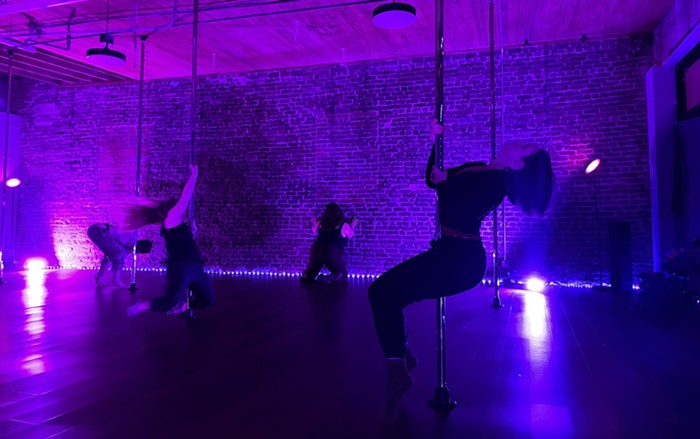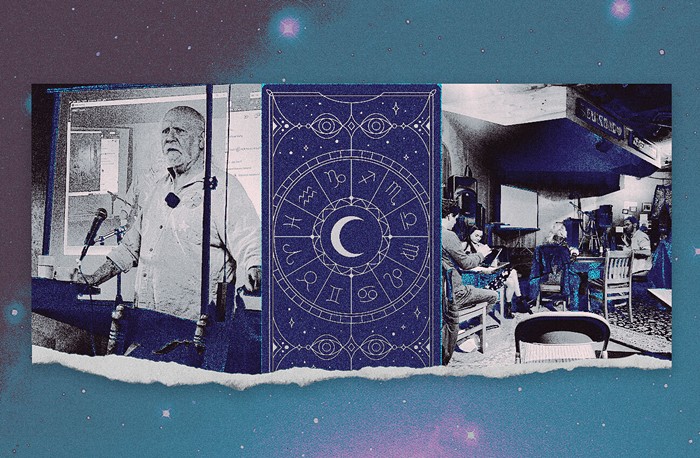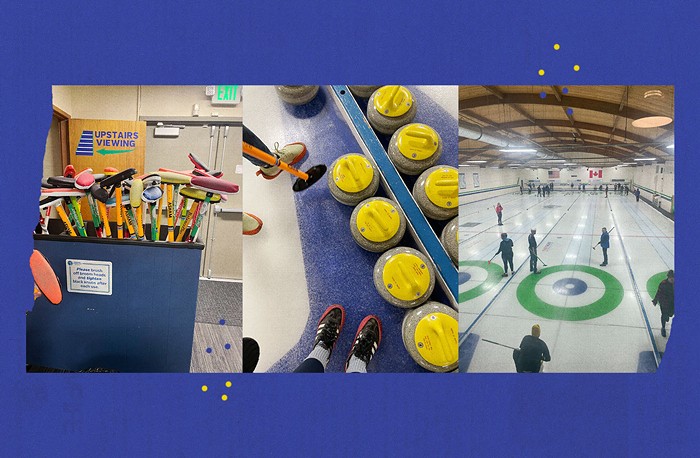I surveyed the map briefly before I plugged one end of the e-punch, a green plastic rectangle strapped to my pointer finger, into the starting checkpoint, otherwise known as a control. United with the e-punch, the control beeped. Time starts now.
I broke into a sprint across Seattle Pacific University’s leafy campus. My partner, in this race and also in all things, Harry, ran ahead of me. I’d roped him into this journey, a 2.7 kilometer-as-the-crow-flies zig-zagging race around the campus to 17 sequential controls.
We threw ourselves up five sets of stairs cutting through the middle of big, white retaining walls that frame SPU’s terraced parking structure. A stitch split my side before we found the first control nestled in the corner of one of those walls. I leaped off the stairs, barreled through a thicket of bushes, and dipped my e-punch into the hole. The control signaled our success with a beep. This was thrilling.
Both panting, we whipped out the map and looked for Control 2.
Harry and I are suckers for a scavenger hunt and fiends for friendly competition. This evening would be perfect for us. Or, at least I thought it would be.
Armed with a loaner compass and a paper map, we ventured into the world of orienteering with Cascade Orienteering Club, a local club that’s been around since 1977. That seems like a long time, but the sport started back in Sweden in the late 1800s.
What Is Orienteering?
The crux of this sport is the maps.
“Orienteering is finding your way through any mapped area with a map,” Bob Forgrave, the president of COC said. Organizers mark control placements on highly detailed, custom-made topographical maps. The maps include buildings, fences, roads, trails, even individual boulders and trees. Orienteers must use all of that information to find the controls and find their way around.
“You’re looking for things on the ground, but your route isn’t mapped,” Forgrave said. “Your route is up to you.”
Forgrave first orienteered in college. He didn't do it again until he stumbled across a course in Woodland Park with his family. He, his wife, and his two daughters have orienteered ever since.
The majority of orienteer events are all-ages, and they take place in more off-the-beaten-path places than SPU’s campus. Typically, they’re set in the woods, a dense trail system, or a rural area. And, they happen in the dead of winter. COC runs a competitive orienteering league that starts in November.
“The goal here is to teach navigation,” Forgrave said. “Great sailors aren’t made in safe harbors. Your comfort zone is a great place to rest, but not much learning happens there.”
The event I joined was part of COC’s relaxed weekly summer series. Will Enger, 36, planned all of these events this year. Enger grew up in Kirkland, and he started orienteering because his dad loved it and made it a family activity. “I thought it was a normal thing for kids to do,” he said.
When he was 12, he ran an orienteering race in Teanaway, Washington, a place where the only details on the maps are rocks and trees.
“I got so lost that I ended up going to a farmhouse and knocking on the door,” he said. “I got a ride back to the event center in the back of this old farmer’s pick-up truck.”
He hasn’t gotten lost like that—in orienteering or in life—ever since.
So, the SPU event was orienteering on easy mode. Got it. I could run around and find things. How hard could using a map be?
Back on the Course
It turns out that using a map is hard.
One of the reasons I brought Harry is because we work well together. I wanted to run a competitive race even though this was my first time orienteering. He also proposed to me this summer during an Amazing Race-style scavenger hunt we had dreamed up and orchestrated for our friends. This was the perfect opportunity to make “Play Date” a little sappy.
Unfortunately, I am not what you would call spatially minded. Harry is.
Fresh off a sprint, I looked at the map while panting for breath. My vision swam. Suddenly, I was back in third grade in Ms. Smith’s class, struggling at school for the first time in my life because I could not figure out how to find the area of irregular figures.
“Do you know where the next one is?” Harry asked, sweat dripping off his nose. His voice ricocheted off the building next to us. All of the buildings looked the same to me.
“Um,” I turned the map this way, then that. “Well, these are the trees, and um, I think we need to head toward this red brick thing, and it should be in the yellow-y lawn?”
“Do you want to put our heads together?” He asked, patient.
I sighed. I did want to put our heads together. I wanted him to do it all because this thing clicked for him and it clearly hadn’t with me, and time was ticking. In our regular life, I trusted him to pick up my slack. But this was for my column where I have to do things myself. I was already cheating at “Play Date” by having him here. I clearly was feeling very complicated.
Aware of him waiting for me and of all the time I was wasting, I looked at the map but didn’t digest any of it.
The map refused to reveal its secrets. “Yeah, will you help me?” I asked.
I handed him the map.
“Let’s orient it so it’s the direction we’re going,” he said, tilting the map. “Control 8 was there.” He pointed on the map. “We passed that building from 9 to 10. We definitely came the right way.” He mused for a second. “It looks like if we keep going along this street we can go until the yellow area and cut over, just like you said.”
I wanted to nod along and pretend I understood the same way I did with Ms. Smith when she explained about adding up and then subtracting the empty space in those irregular figures, but this was Harry. I didn’t have to pretend with Harry.
“I can’t even figure out where the street is,” I said.
He pointed to the tan lines running around the map.
“See that fork?” He pointed to where the street split around an island of grass on the map. “That’s that.” He gestured to the street in real life. Then it clicked for me.
“The tan is the street?” I said. “I’ve been thinking all the black on the maps was asphalt.”
“Oh no,” he said, “those are buildings. All the tan is pavement.”
Note to self: Always read the map key even if you are in the heat of a timed race.
We took off and found the control. The next one was on the opposite side of campus up above the parking structure where we’d found the first control. After I lamented about my contributions, Harry waited for me to make the call on how to get there.
“I just have no memory of where we’ve been,” I said. Truly, I’d never been more disoriented in my life.
“Well, it’s hard because there’s a lot of intensity and there’s a lot of urgency to get to the next one as soon as you get through one," he said. "It's hard to keep track of it all."
I couldn’t imagine how people did this deep in the woods. Yet, despite the frustration with my map skills and my less-than-ideal cardio stamina, I was somehow enjoying myself. The race of it all kept me buoyant. The challenge, while briefly demoralizing, enticed me. I wanted to be good at this. It would definitely not be happening today, though.
Experts in Temporary Confusion
Regardless of the type of course or the type of orienteering (you can do it with pretty much any mode of transportation—bikes, cars, canoes, etc.), the practice takes a special breed.
Patrick Nuss, 42, is an engineer who’s been orienteering for 20 years. According to him, orienteers tend to be “naturally curious people with some grit and resilience.”
“You’re going to need that,” Nuss said. “You’re going to get lost, you’re going to make mistakes, you’re going to get wet and muddy. No race is ever going to be perfect.”
Nuss sat on the grass in the SPU quad in a circle with his five-year-old daughter and his two friends; Kate Byers-Jensen, 43, a former math teacher and current teaching coach, and her wife, sculpture artist Rebecca Jensen, 38. They had all just finished racing.
Byers-Jensen, clad in spandex, interjected, “We don't say lost," she said, "We say temporarily confused."
Orienteering puts participants in “an environment that’s engaging, mental, and gets you taking risks,” Byers-Jensen explained. “You’re in a situation where if you do make a mistake you have to puzzle your way out of it.”
By orienteering, Byers-Jensen builds confidence and adaptability. She practices the skill of getting herself out of a situation she didn’t expect to be in.
As a former teacher, Byers-Jensen loves that in orienteering she’s constantly learning. There’s a social aspect to the post-race where everyone convenes and swaps experiences; what worked, what didn’t work. They make friends orienteering and, with weekly events in the summer and eight competition days in the winter, they never have to make plans to see those friends.
She first got into this when she was dating her now-wife, Jensen. “We didn’t know if I was going to like it or not,” she said. “It 100% could’ve been a deal-breaker if I didn’t, but I didn’t know that at the time.” It worked out. They orienteered on their honeymoon in Iceland.
Jensen laughed. She’d started orienteering back in 2009 when she was jonesing for an activity that would get her out in the woods.
She and an old high school cross country teammate ran their first course together at Lake Sammamish State Park. The whole time, she and the friend were at odds about which direction they should take. It turned out that Jensen’s compass was off, pointing 180 degrees in the wrong direction.
Despite a frustrating, less-than-ideal first time, Jensen was hooked.
“It’s the intersection of something that’s athletic that’s also outdoors and also a game,” she said. “I love being fully engaged like that.”
For Jensen, there’s also an aspect of wanderlust that orienteering satisfies. The sport takes her off the beaten path into areas she wouldn’t normally explore and that other people usually don’t experience.
She explained the feeling by comparing it to staring out the window on a road trip.
“You see the hills and mountains going by, and you just kind of mentally walk up them, you know? I just wanted to start going up them. And you can do that in orienteering," she said.
The Magic of the Treasure Hunt
During the rest of my race, I definitely was not the asset to my team that I'd thought I'd be. Still, I had fun.
We ducked in and around corners of this campus I’d never been to in a corner of Seattle I’d never explored. We ran up and down the hill above the school, jogging through neighborhoods, smelling the woody scent of a barbecue.
Throughout the course, we encountered scores of other orienteers. A pack of lean, unruffled joggers glided past us. A man in his 80s leaned on a walking stick with one hand and carried his map in another. There were families and couples and men in tiny running shorts and plastic sports goggles.
While all of us technically existed on the same plane as the other people on campus—the professors headed home after a long day, the people walking their dogs, even the drivers speeding by—we were in a different world. The magic of this treasure hunt created a bubble of experience, insider knowledge—secrets, truths—only we were privy to.
"Before orienteering, I viewed the world more linearly. Like, 'I'm here, I'm going there,'" COC President Forgrave said. "Now, I'm walking through an unmapped park and I'm looking at all the features. I think about how it all fits together and where I am in it."
Any ideas on which Seattle subculture I should explore next? Want me to tag along with you on your favorite hobby or pastime? Send me tips at playdate@thestranger.com.




















